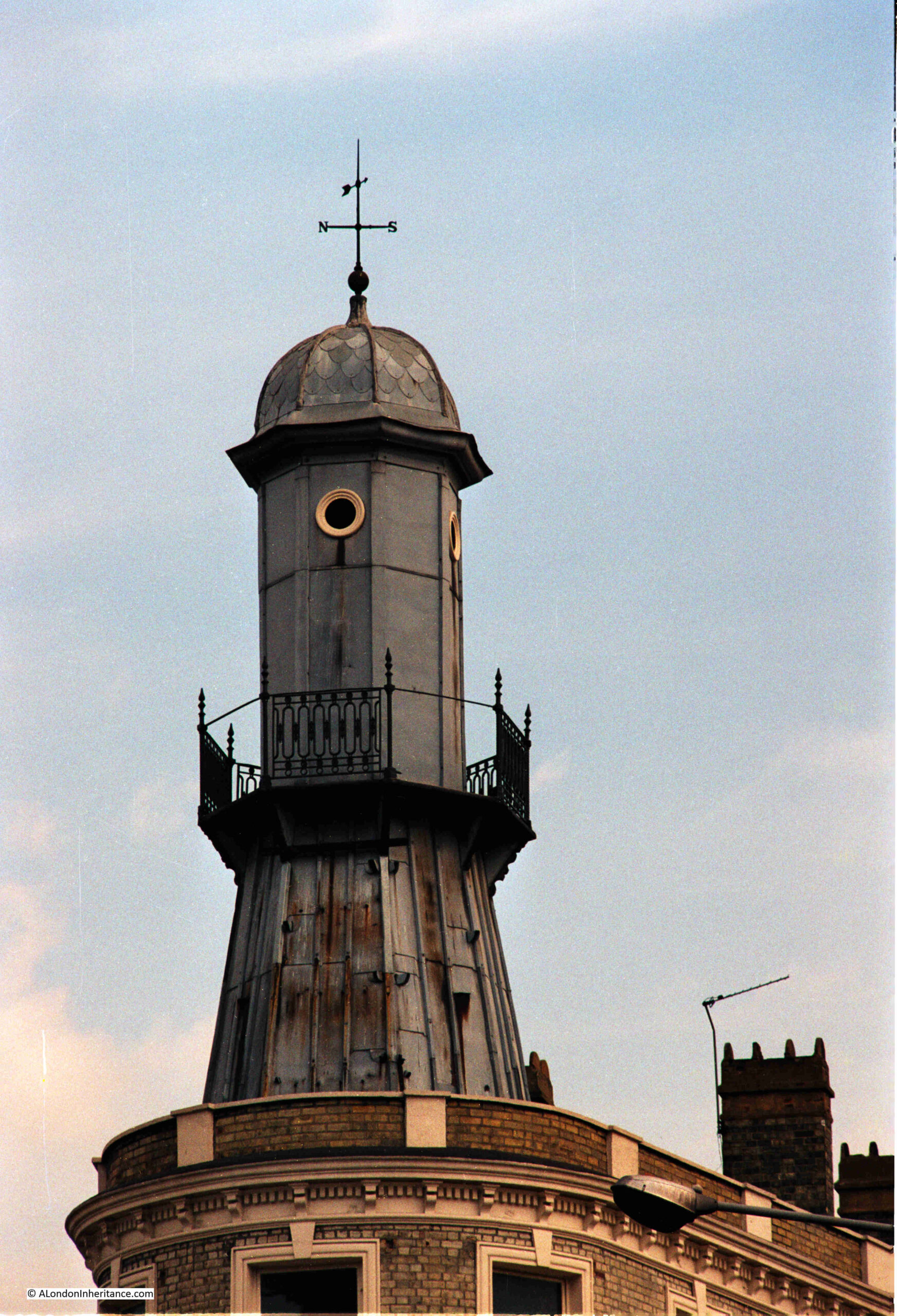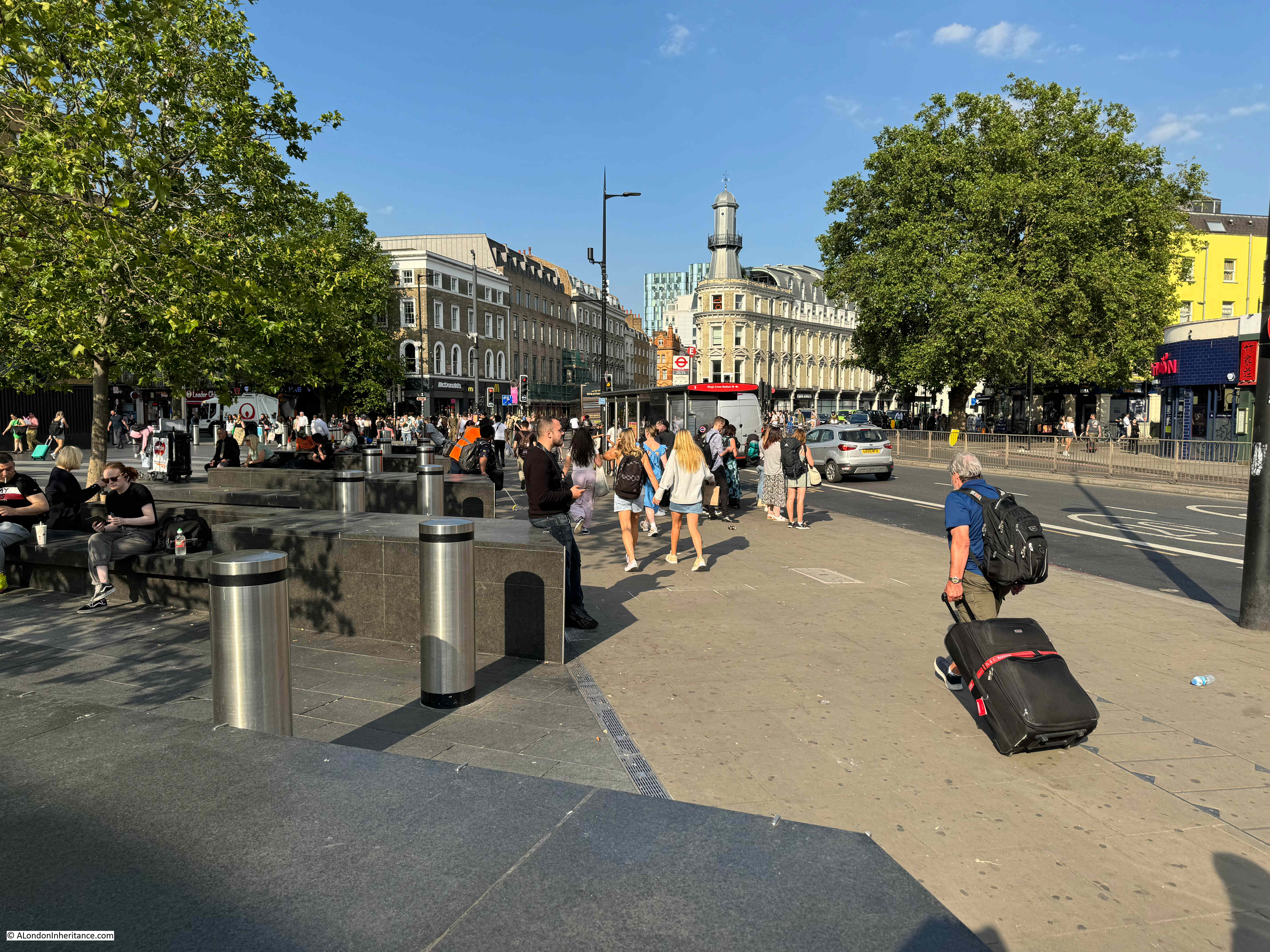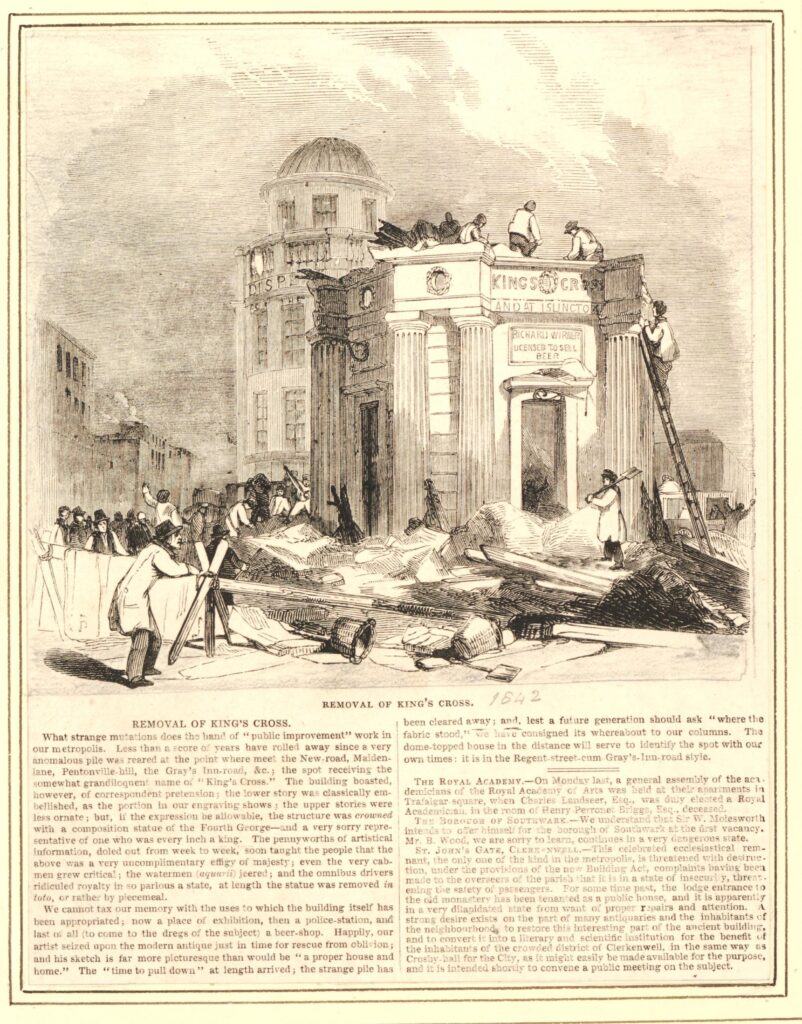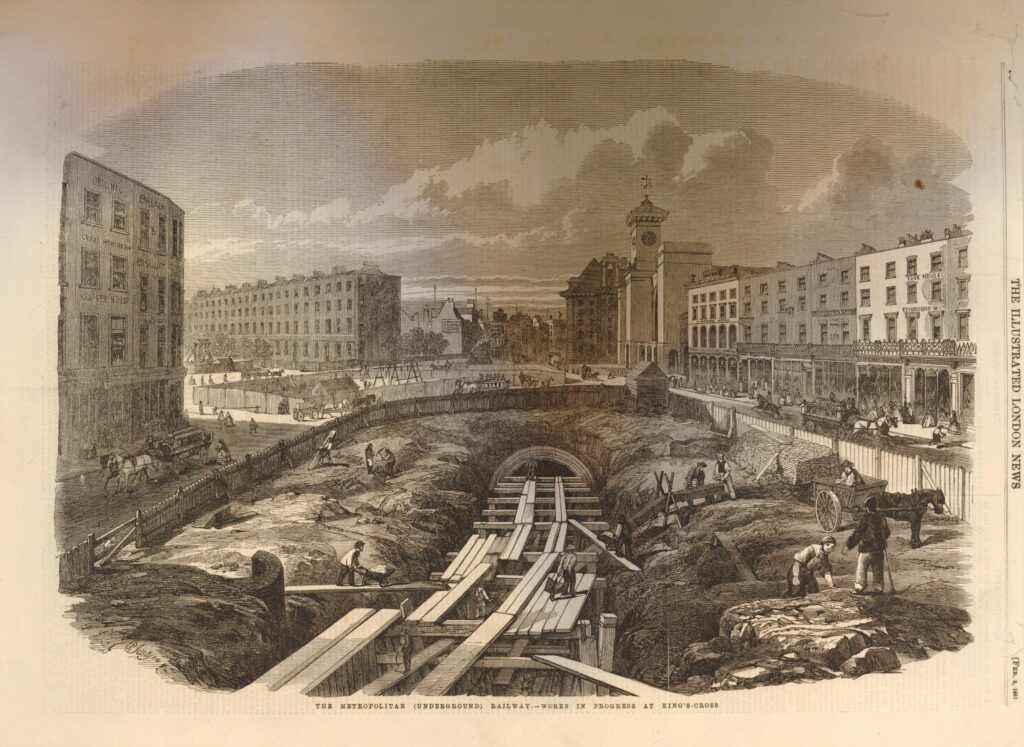There are just three tickets left for my Southbank walk in July. The Barbican walk has now sold out. Click on the link for details and booking:
The following photo is of a rather strange feature on the top of a building looking towards King’s Cross Station. The photo is one of my father’s from 40 years ago in 1984:

I was in the King’s Cross area last week, it was a sunny day, and the sun was in the right position, so I took the following photo showing the same feature as it appears today, along with a view of the building below:

The shape of the building is down to the convergence of the roads on either side, with Pentonville Road on the left and Gray’s Inn Road on the right.
The building is now called the Lighthouse Building, after one of the possible uses of the structure on the roof. The building is Grade II listed, and the Historic England listing includes the following description:
“Above the 3rd floor windows a further cornice and blocking course, surmounted at the apex by a tall lead-sheathed tower, sometimes said to have been for spotting fires, with a cast-iron balcony at half-height, oculus and cornice capped by a small ribbed dome with weathervane finial.”
The listing suggests that the tower was used as a lookout for spotting fires.
Another frequently reported use for the tower was as a lighthouse, and was down to an oyster bar which occupied part of the ground floor of the building. This was “Netten’s Oyster Bar”, and the story goes that when fresh oysters were available in the shop, the light would go on in the “lighthouse”.
I have no idea whether this story is true, or whether the use of the tower for spotting fires is true, of whether it had a different purpose, or was just an ornamental folly.
I found plenty of adverts for Netten’s oyster bar, and the lighthouse was not mentioned in any of these. Netten’s would advertise in the local newspapers of towns where their local station provided a route into King’s Cross or St. Pancras Stations. For example, the following appeared in the Luton Reporter:
“Luton Travelers To London, Should Dine, Lunch, or take Supper at J. Netten’s Fish Restaurant & Oyster Bar, 297, Pentonville Road – King’s Cross.
Boiled or Fried Fish of all kinds in season, fresh cooked for each customer.
Native Oysters 1/- 1/6 & 2/- per dos. Tripe and Onions and Stewed Eels Always Ready”
Rather than native oysters, boiled or fried fish, the traveler arriving in London from Luton today, would find a Five Guys, burger and fries restaurant in the place of Netten’s Fish Restaurant & oyster Bar, so whilst the foods on offer have changed, the need for travelers to buy some food during their journey has not.
The building was completely refurbished in a project that completed around 2013, and this work included the tower on the roof. In previous years the interior had been derelict for some considerable time, and the tower had been a magnet for graffiti. It had been on Historic England’s Buildings at Risk Register, so the refurbishment possibly saved the building. It had been at risk from demolition in previous years from plans to extend the eastern entrances to King’s Cross underground station.
If you go back to my father’s 1980’s photo, you can see that some of the railings around the tower were missing.
In 2016, I was in the clock tower at St. Pancras Station and took the following photo of the area in front of King’s Cross Station (on the left) and the refurbished Lighthouse Building can be seen looking across to the station:

And this is the view from ground level today. A very busy place with plenty of travelers heading to and from the stations of King’s Cross and St. Pancras:

The metal tower, or lighthouse is not the first landmark structure that has been where Pentonville Road and Gray’s Inn Road meet. Before King’s Cross Station was built, there was a structure that would go on to give both the station, and the local area, the name King’s Cross:
© The Trustees of the British Museum Creative Commons Attribution-NonCommercial-ShareAlike 4.0 International (CC BY-NC-SA 4.0)
On the 26th of June, 1830, King George IV died, and in the year before his death, a monument had been proposed, design and construction had started, to commemorate the reign of the king.
The site chosen was at the junction of what is now Gray’s inn Road, Euston Road, and Pentonville Road as from the late 18th century into the 19th century, this area was developing rapidly (even before the arrival of the railways), and the New Road (which would become Euston and Pentonville Roads) had been built as perhaps the first North Circular Road around London to divert traffic away from the centre, to provide a new east – west route, and to take traffic to and from the expanding docks to the east of London.
The print above shows an “Elevation of Kings Cross” as it was intended to appear when completed.
As recorded on the above print, money for the design and build of the monument was being sourced from public subscriptions, however even with building underway, there were not enough funds being received, as recorded in the following article from the London Star on the 2nd of July 1830:
“Whatever may tend towards the recollection of the revered departed monarch will doubtless be received with that degree of loyal feeling which is so characteristic of the true Englishmen.
The splendid National Monument of the King’s Cross (commenced in February last by a few loyal though humble individuals) to commemorate the reign of George the Fourth, approaches now rapidly to completion, and will be finished according to the design of Mr. Stephen Geary, architect. We hesitate not to say it will form one of the most splendid and ornamental objects that adorn the environs of the metropolis, combining not only simplicity of design, but chastity of Grecian architecture.
The Colossal Statue of his late Majesty, surrounded with the emblematical representatives of the Empire, vis. – St. George, St. Andrew, St. Patrick and St. David, will form additions to the various productions of that eminent artist and sculptor, R.W. Seivler, Esq. who is now busily employed upon them.
Although credibly informed, we can scarcely believe the amount of subscriptions received to this public monument are very far from meeting the amount already expended.
Surely a public appeal need only be made, and we doubt whether there is an Englishman, Irishman, Scotchman, or Welshman, who possesses a spark of British loyalty in his breast, who will not subscribe his mite towards handing down to posterity a public token of attachment towards the departed and beloved Monarch, George the Fourth.”
Financial troubles continued, and in 1832 the Kings Cross monument was put up for auction, with the outcome of the auction reported as follows:
“Thursday afternoon, at the Mart, was sold the ornamental, stone-built erection at the junction of the Pentonville, New, Gray’s Inn-lane and Hampstead Roads, partly built by subscription, and intended to receive on its summit an equestrian statue of George the Fourth.
The auction caused a numerous assemblage, and gave rise to much discussion, and it was objected that there was no title, and that the subscribers had a claim upon it, as well as the assignees of the party who had completed it and under whose direction it was being sold. It was further said it might be removed, being built in contravention of the local Paving Act.
The auctioneer admitted that the only title was the written consent of the Commissioners of Roads, and the approval of the Paris Vestry; but it was not liable to any objection as to the local Act, nor was it likely to be pulled down, as it was of great benefit to the public, protecting passengers in the day and serving as a beacon at night.
It was also a great ornament to the district, and had cost nearly £1,000. It was at present let to the Commissioners of Police at £25 a year. the biddings then commenced, and the King’s Cross was knocked down, and bona fide sold for 164 guineas only.”
The only value in the monument seems to have been the small building that formed the base which, as the above article records, was let to the Police, and was generating an income. in the following years it would also become a shop, and finally a pub / bar.
In the years after construction, there also seems to have been a campaign to downgrade the public perception of the quality of the monument, and the statue of King George IV. Newspaper reports tell of cabmen, watermen, and the general public complaining about the statue, and as traffic on the New Road (Euston and Pentonville Roads) increased, the monument was also becoming an obstruction.
In 1841 there was a letter to the editor of the Globe complaining of the dangers of the monument, and that it did not have any surrounding posts or rails to protect pedestrians, and was also unlit at night.
The days of the monument were numbered and in 1842 the statue of the King was removed, and soon after, the whole monument was demolished. Not exactly “handing down to posterity a public token of attachment towards the departed and beloved Monarch, George the Fourth” as suggested in the appeal for public funds a few years earlier.
The following print shows the demolition of the monument:

© The Trustees of the British Museum Creative Commons Attribution-NonCommercial-ShareAlike 4.0 International (CC BY-NC-SA 4.0)
Above the entrance to the room at the base of the monument can be seen the words: “Richard Wirner Licensed To Sell Beer” – the monuments final use.
The text below states that “the dome-topped house in the distance will serve to identify the spot with our own times”, however this building would also soon be disappearing as the area would be part of the construction site for a major transport project. Not King’s Cross or St. Pancras Stations, but the Metropolitan Railway.
The following print shows the cut and cover construction of the Metropolitan Railway, which ran through the site of the George IV monument, and the building that was on the site of the Lighthouse building:

© The Trustees of the British Museum Creative Commons Attribution-NonCommercial-ShareAlike 4.0 International (CC BY-NC-SA 4.0)
The building with the tower / lighthouse on the top was then built on the site in around 1875.
I cannot find a confirmed date for the tower / lighthouse, whether it was part of the original 1875 building, or whether it was added later.
A rather strange story, that a monument that could not raise enough public funds to complete the build, does not appear to have been appreciated by the public, and only lasted for just over 10 years before demolition, gave its name to the area, and to one of London’s major railway stations.
An almost throw away comment in the Lincolnshire Chronicle on the 14th of November, 1845, in an article where the paper reported on the introduction to Parliament of the London and York Railway Bill hints at what would become a nationally recognisable name: “And the said Bill proposes to enact, That the said Railway shall commence in the Parish of St. Pancras in the County of Middlesex at or near a certain place called King’s Cross”.
The tower / lighthouse that overlooks the site of the monument to George IV has lasted much longer, and after restoration, should be there for many more years to come.


There must be millions over the years who have wondered about the lighthouse
Thank you so much for this really interesting article. I worked close by doing National Insurance card exchange in the early 1970s and often wondered about the tower!
My eyes are drawn to the Scala behind and memories of clubbing there. Whoever ran the building was very slack on the nights we were there as you could walk right up to the top. Happily all these photos provoke memories of chaotic club nights. I miss the old Kings Cross.
https://www.amazon.co.uk/Derelict-London-Paul-Talling/dp/1905211430
I’ve got a copy of this book from 2008 and the building is in there in a derelict condition so it was good to see that it later got restored.
We know it well and have always wondered what its purpose was – thank you for another excellent article. Apropos the King’s Cross monument, I notice you have apostrophised it but it had no apostrophe on the actual monument. Nor has the existing station and area. I wonder why and have noticed that many signs in London lack an apostrophe. Is this a deliberate policy of the GLC I wonder?
The GLC ended in 1986. The Greater London Authority started in 2000, but probably local boroughs have street sign responsibility? Sure you can look it up somewhere!
https://en.wikipedia.org/wiki/Greater_London_Council
It is more likely traditional usage in place names & signs, & perhaps a style choice for the tube map. I think it looks tidier in a sign. Grays Inn Road or Gray’s Inn Road, had no apostrophe on an early map for example (see Wikipedia). For some place names, who knows where it should go – would it be Shepherd’s Green or Shepherds’ Green?! 😉
There is another inland lighthouse on Markhouse Road in Walthamstow, also Grade II listed. This one was bulit as part of a Methodist church in 1893. The lighthouse was apparently made part of the design in homage to the sea captain who purchased the land the church stands on, and who was part of the sister congregation in Hackney. I have seen the one at Kings Cross and assumed it had a simialr history, but it appears not!
I was going to comment about our local lighthouse too!
Love all of your posts. Most enjoyable.
As a 76yr old south London girl now living in Scotland I would like it if you could do more about South London.
I don’t usually feel I have anything to add to comments but today, two things. I’m a Ldn cabbie and quite a few years ago picked up an elderly gent, a Kings X local, who told me he was employed as one of the construction workers on the Euston Underpass/Euston Road (1960s). He claimed the lighthouse just mysteriously ‘arrived’ one day and they stuck it on the Kings X junction building because they had nowhere else to put it. Hmm. The other thing that strikes me is how similar in shape the lighthouse is to the George IV monument; and is positioned in the same place. Curious. I’d also heard the oyster bar origin-story. Great post; the mystery remains.
Another very interesting post. I have been passing through that area regularly for over 50 years and there is always something new to learn! I regret that I don’t always tell you how much your work is appreciated. Thank you!
That’s interesting. Often wondered what that lighthouse was.
I’ll go with viewing tower.
I would think you could see far (back in the day it was built ) but why you would want to do that is a puzzle.
Very interesting! I used to walk past that building in 1983-84 as I often used to go dancing at The Bell in Pentonville Road on Friday nights. The lighthouse really was in a sorry state, a bit spooky at night if I’m honest, and we always wondered what it was for. I later worked in Grays Inn Road, 2007-2011 and that lighthouse brought back happy memories whenever I walked past it during the day. So pleased that it has been saved.
I think I noticed the lighthouse back in the 60’s when I used to travel occasionally into kings x from Hertfordshire and then latterly when I travelled to see my girl when I didn’t go by greenline although latterly it was of the train then onto the underground I suppose thistles line being the successor to the metropolitan also mentioned so then not seeing the light of day until I emerged at hanger lane but things like that do stick in the mind. Still the mystery remains , perhaps it was intended as a replacement monument to George 1V but again was never completed. We shall probably never know, just another English eccentricity to ponder on. I do enjoy your posts although too old and too far away to enjoy in person these virtual strolls through part of my youth are very welcome
Thanks for this very interesting article. I seem to remember either reading or being told that the ‘lighthouse’ was an observation post and signalling post for tram traffic……no idea of the truth or otherwise!
I went to a talk on the Lighthouse Building a few years ago with accompanying slideshow. There is an access door, but no access to the balcony; in any event, the balcony is too narrow for anyone to stand on with a shoe size greater than about a 10; I would suggest it’s a folly with no practical human use.
I used to walk down from Temple to Holborn and then along Grays Inn Road to King’s Cross Station every day back in the 70s and much of the 80s and often wondered what the tower was.
I used to visit Dobells jazz record shop which used to be in one of the shops along by the lighthouse and also went to the Scala cinema which was nearby. Kings Cross was certainly much different from what it is today.
Thank you for this post and all your others.
It is also curious that it was called King’s CROSS, as there was no cross at the top, just a statue. I guess it refers to the cross-roads, although Charing Cross has a cross on top, and is not at a junction ( but it used to be ). I wonder whether all the other crosses erected to Eleanor were on crossroads ? Thanks for another fascinating piece.
For 30 years I lived in York Way, formerly Maiden Lane, from Midden Lane (the huge pile of ash from coal fires was exported to Russia I think for the foundations of St Petersburg, but I’d have to check), & used to walk past every day when I worked at the now closed (2020) RNTNE Hospital library in Gray’s Inn Rd. Have you noted the odd stone that must be (?) an old mile stone, on the south side? Also, note the flat used by Michael Caine as Harry Palmer in The Ipcress File, is at the top south side of Grays Inn Rd, where there is still the ghost of a vey old wall advert still just visible.
Fascinating read and also some of the comments
Just commenting that the structure can be seen in a photo of the area dated as 1899.
https://www.reddit.com/r/TheWayWeWere/comments/zy03w8/kings_cross_railway_station_london_1899/